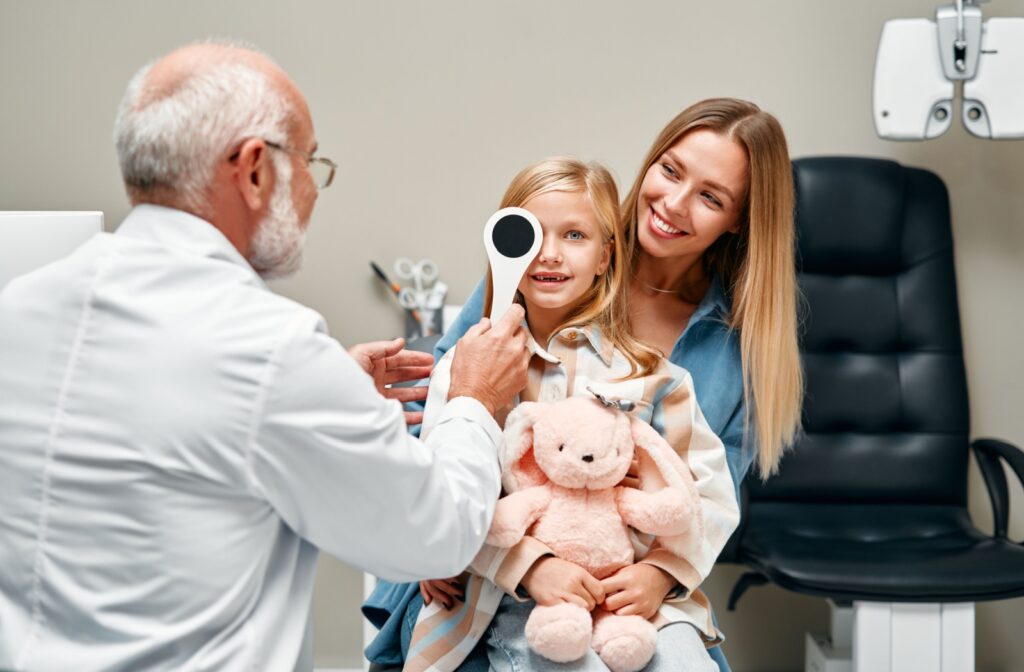When life gets hectic, our wellness tends to take a backseat. Although it’s easier said than done, investing in your health is always worth the time and effort.
Even if you don’t wear glasses or contacts, everyone benefits from routine eye exams. The recommended frequency of these visits, however, varies depending on age, vision concerns, and overall health status.
As a general rule:
- Children (up to 19 years) should have an annual eye exam.
- Adults (20-59) can get by with an eye exam every two years.
- Seniors (60 and older) should have an annual eye exam.
If you wear contact lenses, have general health concerns, or have a family history of eye disease, annual eye exams are the way to go.
Skipping an eye exam is never worth the risk. Routine eye exams are your first line of defence against potential concerns.
Importance of Routine Eye Exams
You might be surprised to learn that the eyes give us valuable insights into your overall health. That’s why routine eye exams are an important window into your health.
Just as you visit your family doctor and dentist for regular check-ups, you should also schedule routine eye exams. Beyond updating your vision prescription (if you need one), these exams can detect potential concerns early, preserving your eyesight.
Certain eye conditions, like glaucoma and macular degeneration, develop silently. By the time most people notice symptoms, permanent damage has often already occurred. Scheduling regular eye exams encourages timely intervention, facilitating better management results.
Besides, a prescription for eyeglasses is only valid for up to two years.
Factors That Determine Exam Frequency
Although everyone benefits from these visits, the frequency of these exams varies from person to person. Age is a general guideline, but as always, there is nuance to this.
Here’s a closer look at why:
Age
With age comes time and change, affecting your visual and ocular health. Here’s a general breakdown:
Children (Up to 19 Years)
Eye exams start early, even before learning your ABCs
Children can have their first eye exam as early as 6 months, followed by another at age 3, and then annually once school begins. Regular monitoring helps verify proper eye health and development as children’s eyes grow, making sure that visual concerns don’t interfere with learning.
Besides, young eyes are more responsive to treatment, facilitating better results for lifelong strong vision.
Adults (20-59 Years)
Vision fluctuates throughout childhood and adolescence, and stabilizes at around age 20. For this reason, adults 20-59 can get by with an eye exam every two years, assuming they have no pre-existing conditions.
Annual eye exams are always an option if you feel you need a visit sooner.
Seniors (60 and Older)
Older adults are more susceptible to age-related eye conditions, like cataracts, macular degeneration, and glaucoma, making annual exams ideal for anyone 60 and older.

Vision Concerns
How often you get an eye exam can also depend on your specific vision needs.
Frequent Screen Users (Digital Eye Strain)
If you spend hours daily on computers, tablets, or phones, you may experience digital eye strain, dry eyes, or blurry vision.
If this sounds familiar, scheduling an eye exam annually is a good idea. Your optometrist can help you manage symptoms effectively and can even guide you on lens options to support screen time.
Contact Lens Wearers
Contact lenses offer a break from glasses, but require greater maintenance and care, hence, annual contact lens exams and fittings. Annual exams verify that your lenses fit properly, your eyes remain healthy, and your prescription is precise. Your vision can change a lot, even in a year!
Changing Vision
If you notice yourself squinting more to read road signs or have frequent headaches, these symptoms suggest it might be time for an eye exam. A routine visit can determine whether the driving force behind these symptoms is a refractive error or something else.
General Health Conditions
Your overall health can have a significant impact on your eyes. People with certain health conditions may need more frequent eye exams.
Diabetes
Diabetes poses a risk for diabetic retinopathy, which can lead to permanent vision loss if left unchecked. People with diabetes should have annual diabetic eye exams to catch symptoms early.
Hypertension
High blood pressure can cause changes in the blood vessels at the back of the eyes, contributing to elevated eye pressure and increasing the risk of developing glaucoma. Regular monitoring can help spot complications early, especially because glaucoma develops quietly, often without noticeable symptoms in its early stages.
A Family History of Eye Disease
If eye diseases like glaucoma, macular degeneration, or cataracts run in your family, your optometrist might recommend more frequent exams.
What to Expect During a Routine Eye Exam
The exam’s details will vary depending on age, vision needs, and health history. Here’s what a typical session might look like:
- Health and Vision History: Your optometrist will go over your medical history, lifestyle details, and any current concerns or symptoms.
- Vision Testing: This involves reading a standard vision chart or assessing near, intermediate, and distance vision.
- Eye Health Evaluation: Using modern imaging tools, your optometrist will check for underlying conditions affecting your vision or health.
- Prescription Updates: If necessary, your optometrist will update your prescription so you can enjoy the comfort of visual sharpness.
Each test serves a specific purpose. Together, they create a complete picture of your eye health so that nothing is overlooked.
When in Doubt, Check it Out
Your eyes support you tirelessly in your daily adventures. Give them the care they deserve with routine eye exams.
Staying regular in these visits can help safeguard your sight and prevent minor concerns from snowballing into more complex cases. If it has been a while since your last exam or you are due for a prescription update, connect with our Vision Care Centre team to schedule a visit!



